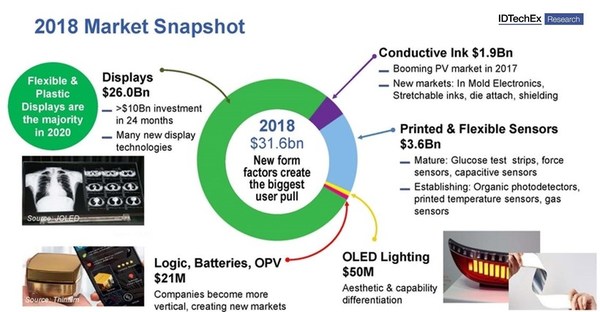


BOSTON, Oct. 29, 2018 /PRNewswire/ -- The total market for printed, flexible and organic electronics in 2018 is $31.6 Billion, broken down in Figure 1. This is based on new research conducted by IDTechEx for the report Flexible, Printed and Organic Electronics 2019-2029.
Displays are the largest segment with OLED displays, being mostly not printed, are $25.5 Billion, with other displays the rest (mostly electrophoretic displays used in e-readers and for electronic shelf labels). The OLED display industry has hit some milestones: in 2020 the number of OLED displays on plastic substrates will have overtaken those on glass substrates. Plastic-based versions are thinner, lighter and can be curved, and are a stepping stone to truly foldable displays. Later this year in China, Nubia is set to launch the first foldable commercial OLED display with Huawei and Samsung hot on their heels.
Inkjet printed OLED displays is now also a reality, thanks to JOLED. It's been many years in the coming, as pictured in Figure 2, and JOLED continue to develop an IP portfolio which it intends to license.
At the World's largest event on printed, flexible and organic electronics – Printed Electronics USA 2018 which will be held on Nov. 14-15 in Santa Clara, CA - organizations including JOLED, Visionox, Royole, KITECH, Ynvisible, Clearink and many others will be presenting on the latest printed and flexible display innovations.
Printed Electronics: a $5.8 Billion market in 2018
Of the total $31.6 Billion market in 2018, the value of components predominately made by printing is $5.8 Billion in 2018 rising to $8.5 Billion in 2029.
The largest application using printing by market value is printed glucose test strips, however, this is a market in decline as governments around the world reimburse less of the cost to manufacturers pushing down the cost. Blood glucose test strips are the gold benchmark of monitoring blood sugar levels – providing highly accurate readings, but the decline is being offset by the growing market for continuous monitoring, enabled in part by flexible electronics.
As shown below, continuous monitoring is not as accurate, but provides far more data points and is more comfortable to use. Relative changes in readings from the continuous glucose monitors provide the user with actionable information since the data is almost in real time and continuous.
Printed Electronics USA 2018 assesses these trends with speakers from healthcare organizations including Boston Scientific, Siemens Healthineers, Nissha Si-Cal, TempTraq, PolyPhotonix, Proteus and many more.
Printed glucose test strips are just one type of printed sensor, with other commercial examples being printed force sensors (piezoresistors) and printed capacitive sensors. Another trend in sensors is hybrid electronics, combining both conventional and printed electronics in one device. One application example that is emerging are inexpensive RFID based sensors, using an RFID silicon chip in addition to a printed sensor and antenna, creating a simple but effective wireless sensing device. These can be sued to monitor strain, hotspots on critical machinery and moisture in vehicle manufacturing processes.
Momentum Grows in Structural Electronics
Bulk, flat electronics is changing: not only are devices becoming flexible and even stretchable with the advent of stretchable printed conductors enabling e-textiles, but electronics is also now increasingly 3D, matching the world we live in.
Key enablers here are In-Mold Electronics (IME) and 3D Printed Electronics. IME is predominately being targeted for automotive and white goods applications, but also appearing in other products, including wearables. Growing markets include spraying or printing conductive ink over the 3D surface of electronics to create electromagnetic shielding, particularly needed for 5G hardware which operate at high frequencies.
Structural electronics is a strong feature at Printed Electronics USA 2018, with coverage of the range of materials, manufacturing processes and of course devices that are being created. For more information about the World's largest event on printed electronics, featuring over 250 speakers, 270 exhibitors and with over 3,500 attendees expected, see www.PrintedElectronicsUSA.com.
For a full analysis of the industry based on over 18 years of assessment, see the new IDTechEx report Flexible, Printed and Organic Electronics 2019-2029. This report provides the most comprehensive view of the printed, organic and flexible electronics industry, giving detailed ten-year forecasts by device type along with assessment of the trends, capabilities and market successes (and failures). The market is analyzed by each key component type in addition to assessing the market value by printed vs nonprinted, rigid vs flexible and much more.
Media Contact:
Charlotte Martin
Marketing & Research Co-ordinator
c.martin@IDTechEx.com
+44(0)1223 812300
www.IDTechEx.com
Related Images
figure-1.jpg
Figure 1.
Printed, Flexible and Organic Electronics: 2018 Market Snapshot.Source: IDTechEx report Flexible, Printed and Organic Electronics 2019-2029
figure-2.jpg
Figure 2.
The History of Printed OLED Displays. Source: IDTechEx report Flexible, Printed and Organic Electronics 2019-2029
figure-3.jpg
Figure 3.
Bio sensing: Continuous monitoring. Source: IDTechEx report Flexible, Printed and Organic Electronics 2019-2029
Related Links
SOURCE IDTechEx
